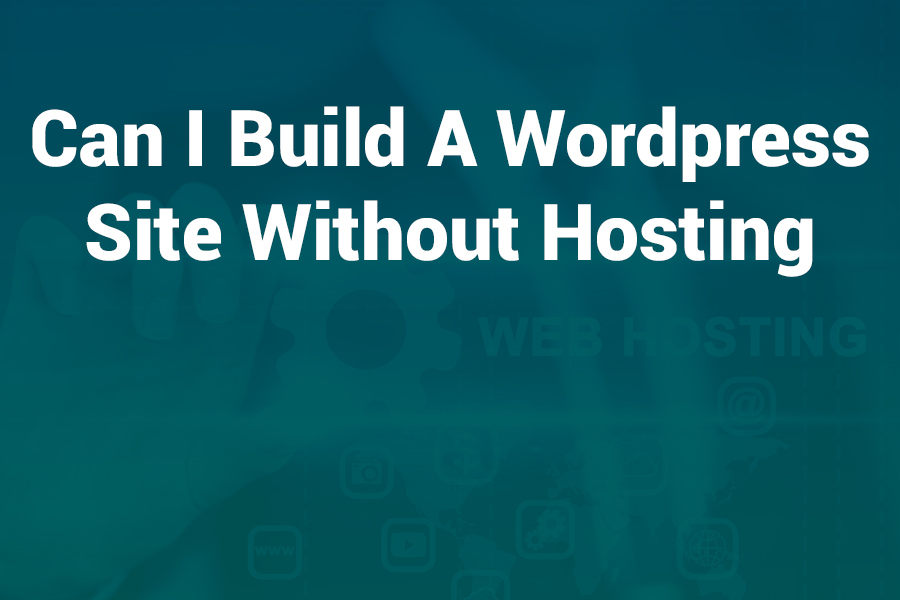Can I Build A WordPress Site Without Hosting

Building a website often feels like it starts with buying hosting and a domain. Yet many beginners wonder if it is possible to build a WordPress site without hosting. The short answer is yes, you can.
There are several methods that allow you to test, practice, or even run a website without paying for traditional hosting upfront. These options give you a safe way to learn, experiment, and plan before making your site public.
In this article, you will learn the main ways to build a WordPress site without hosting, what limitations to expect, how each option works, and when it makes sense to use them.
Why You Might Want to Skip Hosting at First
Not everyone is ready to launch a full site immediately. Some want to practice WordPress before spending money. Others need a place to test themes, plugins, or custom code without breaking a live site.
Many freelancers or agencies prefer building locally to avoid errors in front of clients. Avoiding hosting upfront also helps reduce costs while you experiment. These situations make building a WordPress site without hosting a practical first step.
Method One: Use WordPress.com Free Plan
WordPress.com is a hosted version of WordPress managed by Automattic. It offers a free plan where you can create a website without paying for hosting. You get a free subdomain such as yoursite.wordpress.com. This allows you to start publishing right away without technical setup.
The free plan includes basic features, but it comes with restrictions. You cannot install custom plugins or upload premium themes. Monetization options are limited. Storage space is capped. If you want a custom domain, you must upgrade to a paid plan. However, for beginners who just want to learn WordPress, the free plan is a great option. It provides access to the WordPress dashboard, content editor, media library, and core features.
Method Two: Install WordPress Locally
Another option is to install WordPress on your computer. This method does not require an internet connection or hosting provider. Instead, you use software that mimics a server environment. Popular local development tools include LocalWP, MAMP, WAMP, XAMPP, and DevKinsta.
The process is simple. First, download and install the local server software. Then create a new site within the program. The tool sets up a local server, database, and WordPress files. You can then access your WordPress dashboard through a local URL such as localhost/mysite.
This option has many benefits. You can test plugins, design pages, and configure settings without worrying about breaking a live site. It is fast because everything runs on your computer. You can work offline. It is also secure, since outsiders cannot access your local site. The downside is that no one else can see the site unless you move it to live hosting.
Method Three: WordPress Playground
A newer method is WordPress Playground. It is a browser-based sandbox where you can run WordPress instantly without installation or hosting. It uses WebAssembly to simulate PHP and MySQL directly in your browser. You just visit the site, click start, and a temporary WordPress environment launches.
This is perfect for quick testing or showing someone a demo. You can install themes, create pages, and even test plugins. However, the site does not persist long term. Once you close the session, your work may be lost. Playground is best for temporary use and practice.
Method Four: Refundable Hosting Trials
Some hosting companies provide free trials or money-back guarantees. You can sign up, install WordPress, and experiment. If you cancel within the trial period, you receive a refund. While this involves a hosting provider, it allows you to test without financial risk. You also get to practice on a real server environment, which helps when you later move to a permanent host.
Method Five: Build Without Going Live
Even with hosting, you can keep your site private until ready. You can use maintenance mode plugins or build your site in a staging environment. Tools like Duplicator or staging platforms let you design and test before going public. While this technically involves hosting, it achieves the same result: building without exposure.
Benefits of Building Without Hosting
Creating a WordPress site without hosting has many advantages.
- It lowers costs while learning.
- You can experiment freely without risk.
- Mistakes do not affect visitors.
- It provides a safe space for beginners.
- Developers can test plugins or themes privately.
These benefits make it especially attractive for students, bloggers starting out, and small business owners still deciding on design.
Limitations You Should Expect
Of course, there are trade-offs. With WordPress.com free plan, customization is limited. With local installations, your site is not online until you migrate it. With WordPress Playground, nothing persists long term. Refundable trials still require a payment method. And with staging environments, you technically need hosting. Understanding these limits helps you choose the best option.
Choosing the Right Approach
The right choice depends on your goals. If you only want to learn the WordPress interface, WordPress.com free plan or Playground is enough. If you plan to build a full site before going live, local installation is better. If you want real server practice, refundable hosting is smart. If you already have hosting, staging tools let you work safely without going live too soon.
Steps for Local Installation
For many beginners, local installation is the most flexible method. Here is a simplified process:
- Download and install a local server program such as LocalWP.
- Open the program and create a new site.
- Choose your site name, PHP version, and database settings.
- The tool sets up everything automatically.
- Log into WordPress using localhost credentials.
From there, you can install themes, add pages, and test plugins just like a live site.
Moving From Local to Live
At some point, you may want to move your site online. Migration tools make this process simple. Plugins such as Duplicator or All-in-One WP Migration export your local site and import it into a live host. This allows you to design offline and then publish once ready.
Why Hosting Still Matters Eventually
While you can avoid hosting in the early stages, eventually you will need it if you want your site to be public. Hosting provides storage, security, speed, and global access. Choosing a reliable host ensures your site loads quickly and stays online. But by starting without hosting, you can reduce costs and stress while you prepare.
The Best Way for Beginners
If you are brand new, the simplest path is WordPress.com free plan. It removes technical setup and lets you focus on content. If you are slightly more advanced, local installation gives you maximum freedom. Developers or agencies should use staging environments. Each method works, but the choice depends on skill level and goals.
Tips for a Smooth Experience
- Keep backups of your work, even if offline.
- Learn the basics of WordPress themes and plugins before going live.
- Use free themes to practice design.
- Test common plugins like contact forms, SEO tools, and page builders.
- Plan your content early so migration to live hosting is easier.
Final Thoughts
Yes, you can build a WordPress site without hosting. Multiple methods exist, from free WordPress.com plans to local development tools and browser-based sandboxes. Each has benefits and limits, but all provide a safe way to learn and experiment.
While hosting will be necessary eventually for a public site, avoiding it at the start makes sense for beginners and testers. By using these options, you gain skills, confidence, and a ready site before spending money.
